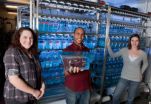(Press-News.org) COLLEGE STATION — A team of Texas AgriLife Research engineers has developed a way to cut by as much as half the amount of irradiation needed to kill 99.999 percent of salmonella, E. coli and other pathogens on fresh produce.
By packing produce in a Mylar bag filled with pure oxygen, Dr. Carmen Gomes, AgriLife Research food safety engineer, and her colleagues found they could significantly reduce the amount of radiation needed to kill those pathogens. Reducing the amount of radiation is not so much a safety measure as it is a way to preserve quality of the produce, she said.
The U.S. Food and Drug Administration recently approved the use of irradiation at dosages of up to 4,000 Gray on leafy greens such as spinach, Gomes said.
A Gray is a measure of ionizing radiation dose and it is equal to the absorption of 1 Joule of ionizing radiation by 1 kilogram of matter.
"That dosage was determined as what was necessary to achieve an 100,000-fold reduction of such pathogens as E. coli O157:H7 and salmonella," said Gomes, who is one of athethree-member Texas AgriLife Food Safety Engineering Team. "However, we know based on previous research conducted by our group that above 1 kilo Gray (1,000 Gray) the quality of leafy vegetables starts to decay and they lose their freshness."
An 100,000-fold reduction corresponds to a 99.999 percent kill rate, according to Dr. Rosana Moreira, another member of the team.
"If you had 100,000 bacteria in your vegetable, it means you would end up with just one bacteria still living," Moreira said.
Though being exposed to a Gray of radiation would be lethal for a human, the radiation leaves no residue on the vegetables, and the vegetables are perfectly safe for human consumption after the process, according to Gomes.
"It is analogous to the heat treatment when you expose milk, juices and cans of vegetables to very high temperatures for a period of time to kill pathogens," Gomes said. "If we humans were exposed to the same heat treatment we would suffer heat trauma as well. Moreover, the irradiating process is very well regulated. The energy of electrons we use is too low to produce radioactive materials."
Also, ionizing radiation it is not so likely to reduce nutrients such as chlorophyll, carotenoids and valuable antioxidants as thermal processes do, said Dr. Elena Castell-Perez , the third member of the team.
"Ionizing radiation can actually enhance some nutrients such as carotene and other antioxidants," Gomes said. "And irradiated food stays fresh longer."
But no matter how healthy and safe to eat, few consumers would want their lettuce a bit on the mushy side. Consequently, the team was looking for ways to reduce the amount of ionizing radiation without reducing its effectiveness in killing pathogens.
An electron-beam gun is typically used to irradiate food for several reasons, Gomes said. Electron beams will kill pathogens without using a radioactive material for a source. But electron beams also generate ozone, a corrosive form of oxygen, which is a drawback for many applications. However, ozone has a bactericidal function as well.
"Therefore, though it (ozone) was something that was considered detrimental in irradiation facilities, we decided to work to our benefit and use it synergistically with irradiation," Gomes said. "The question we asked was, 'What if we irradiate a bag of fresh produce with enough oxygen inside that it becomes ozone? Will that allow us to decrease the required dose?'"
Working with this concept, the researchers packed the vegetables in Mylar bags filled with pure oxygen, a nitrogen oxygen mix or plain air. Prior to bagging, the team uniformly inoculated both fresh and frozen spinach samples with a cocktail containing either salmonella or listeria cultures. They then subjected the sample bags to various levels of radiation, ranging from 0.2 to 1.25 kilo Gray.
After irradiation, the team tested the samples for pathogens. Their test showed modified packaging containing either pure oxygen or the nitrogen/oxygen mix increased the sensitivity of salmonella or listeria to radiation without changing the way the radiation affected the vegetables, Gomes said.
Better yet, she added, the ozone, the only byproduct that might be considered hazardous to human health, naturally coverts back to oxygen within an hour.
"So, there is no harm done at all," Gomes said "This allows the processor to irradiate the produce at lower doses and still kill the pathogens. The good thing about this is that product quality is assured."
The other widely used commercial means of removing pathogens on fresh produce is to either wash them with fresh water or use a water-bath of 200 parts per million chlorine, Gomes said. Though both treatments are better than none at all, they are not effective at completely removing the pathogens, which can hide in deep recesses or air pockets within the produce.
But the pathogens can't hide from ionizing irradiation, and unlike chlorine treatments, the process doesn't leave an aftertaste, she said.
According to the Texas AgriLife Extension Service, foodborne diseases cause an estimated 76 million illnesses, 325,000 hospitalizations, and 5,000 deaths each year in the U.S. More information on foodborne illnesses can be found at the Family and Consumer Sciences website at http://fcs.tamu.edu/fcs_programs/2010briefs/fpm-2010-brief.pdf .
The AgriLife Research Food Safety Engineering Team began work in 2002 with a $1 million U.S. Department of Agriculture grant. The team is the only one in the nation doing research that focuses on accurate dose calculations and dose distribution within a variety of complex-shaped foods, such as blueberries, bagged spinach and lettuce, mangoes and cantaloupes, according to team members.
Since the team's inception, they have worked with other technologies such as modified atmospheres and antimicrobial films. More info on the team and their work can be found at http://moreira.tamu.edu/FSEngr/FSENGR.html .
###
END
PITTSBURGH—Computer-related technology is increasingly driving the U.S. economy, yet computer science education is scant in most American elementary and secondary school classrooms and the number of introductory and Advanced Placement courses in computer science has actually declined in the last five years, according to a report released this fall.
"Some states and some schools are offering some really excellent courses," said Mark Stehlik, co-author of the report, "Running on Empty: The Failure to Teach K-12 Computer Science in the Digital Age," http://www.acm.org/runningonempty/. ...
How do ecosystems develop? No one really knows, yet. There is however one project, unique in the world, seeking to answer this question. In a former open-pit coal mining area in Brandenburg, Germany, a surface of six hectares was partitioned off and then left to its own resources. Scientists from the Technische Universitaet Muenchen (TUM), in collaboration with researchers from other institutions, are studying the development of soil, flora, and fauna there. With this research they aim to establish the factors that have a particularly strong influence on developing ecosystems.
Young ...
CHICAGO --- Post-traumatic stress syndrome – when a severely stressful event triggers exaggerated and chronic fear – affects nearly 8 million people in the United States and is hard to treat. In a preclinical study, Northwestern Medicine scientists have for the first time identified the molecular cause of the debilitating condition and prevented it from occurring by injecting calming drugs into the brain within five hours of a traumatic event.
Northwestern researchers discovered the brain becomes overly stimulated after a traumatic event causes an ongoing, frenzied ...
New research at Rice University could ultimately show scientists the way to make batches of nanotubes of a single type.
A paper in the online journal Physical Review Letters unveils an elegant formula by Rice University physicist Boris Yakobson and his colleagues that defines the energy of a piece of graphene cut at any angle.
Yakobson, a professor in mechanical engineering and materials science and of chemistry, said this alone is significant because the way graphene handles energy depends upon the angle -- or chirality -- of its edge, and solving that process for ...
Investigators report no evidence of toxicity in the four hemophilia B patients enrolled to date in a gene therapy trial using a vector under development at St. Jude Children's Research Hospital and UCL (University College London) to correct the inherited bleeding disorder.
This trial was designed primarily as a safety test, with low and intermediate doses of the vector expected to produce little detectable Factor IX. The Factor IX protein helps the blood form clots. Individual with hemophilia B lack adequate levels of this clotting factor. The first participant in the ...
People with psychotic disorders, such as schizophrenia or bipolar disorder, are 12 times more likely to commit suicide than average, according to research released today by King's Health Partners.
The research found that the rate of suicide was highest in the first year following diagnosis (12 times national average) and that high risk persisted – remaining four times greater than the general population ten years after diagnosis, a time when there may be less intense clinical monitoring of risk.
Neither the risk of suicide nor the long-term risk of suicide, as compared ...
CORVALLIS, Ore. – It's illegal for businesses and law enforcement to profile a person based on their race, gender, or ethnicity, yet millions of Americans are being profiled every day based on their online consumer behavior and demographics.
Known as consumer profiling for behavioral advertising purposes, this type of profiling is largely unregulated.
The result, according to two recent articles in the journal of Computer Law & Security Review, is that consumers have less privacy and are being targeted by advertisers using increasingly sophisticated measures, which ...
It is supposed to be cool, colorless, tasteless and odorless. It may not have any pathogens or impair your health. This is the reason why drinking water is put to a whole series of screenings at regular intervals. Now, the AquaBioTox project will be added to create a system for constant real-time drinking water monitoring. At present, the tests required by the German Drinking Water Ordinance are limited to random samples that often only provide findings after hours and are always attuned to specific substances. In contrast, the heart of the AquaBioTox system is a bio-sensor ...
A gene that can cause congenital heart defects has been identified by a team of scientists, including a group from Princeton University. The discovery could lead to new treatments for those affected by the conditions brought on by the birth defect.
Princeton researchers focused on identifying and studying the gene in zebrafish embryos, and the team's work expanded to include collaborations with other groups studying the genetics of mice and people.
"This work really showcases the use of collaborative science and multiple model systems to better understand human disease," ...
AUGUSTA, Ga. – A drug prescribed for Parkinson's disease may also treat restless leg syndrome without the adverse side effects of current therapies, Medical College of Georgia researchers say.
Rasagaline works by prolonging the effect of dopamine, a chemical that transmits signals between nerve cells in the brain. The cause of RLS is unknown, but research suggests a dopamine imbalance. Parkinson's is caused by a dopamine insufficiency.
"The hope is that Rasagaline, because it prolongs the effect of existing dopamine, instead of producing more, will not come with adverse ...



